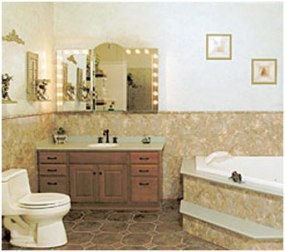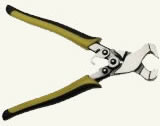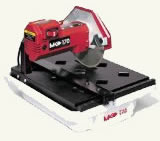
Figure 1 - Tile used on a bathroom wall
Installing bathroom wall tile is a project that most diy home handymen are quite capable of completing with a professional appearance. It is a home improvement that will definitely increase the value of a home.
Bathroom wall tiles are manufactured in almost every country and exported to other's.

Figure 2 - Tile cutter

Figure 3 - tile nipper

Figure 4 - wet saw
The most common bathroom wall tile is a ceramic 4″x4″ square. Because of its small size, installation is relatively easy. The tiles are light in weight and can be trimmed to size with a manual tile cutter, as shown in Figure 2 and a hand nipper, as shown in Figure 3. Holes for faucets and shower heads are easily drilled or nipped. It is important to buy the right tools to do the job, but they are relatively inexpensive.
Additional information on drilling holes in:
As marble tile has come down in price dramatically, many people are going to the elegant look of real stone. Marble is heavier and has a higher density than ceramic, as does porcelain, and requires a specially designed power cutting tool, a wet saw, as shown in Figure 4.
Wet saws do not have to be purchased, they are available to rent from most rental stores. As well, many of the businesses that sell natural stone and porcelain tiles will have wet saws available to rent.
All tiles have batch numbers, this applies to natural stone or manufactured. This means that there will be color variations between batches. It is important to buy enough tile, all with the same batch number before you start to ensure that you will have enough to complete the project. It is highly unlikely that you will be able to get the same batch number two weeks later. Most tile retailers will allow you to return unused tiles. It is also wise to keep a few spare tiles from the original batch for possible repairs in the future.
The key to a good installation, as with any tiling project is the preparation of the surface that the tile will be mounted on. Tile, no matter if it is marble, ceramic or porcelain will not correct defects in the wall. If the intent is to correct defects in wall you should consider a shower or tub enclosure
The wall, prior to the tile installation should be made of water resistant drywall (green board as it is sometimes termed), or concrete board. The joints should be sealed in the same manner as if you were using the board as the finished surface. Do not try to install tile of any type over drywall that is rotting or does not have a reasonably smooth surface as you are only accomplishing short term gain for long term pain.
Concrete Board / Green Board Calculator
There are many types of adhesives, depending on the subsurface and the tile. Read and follow the manufacturers instructions - believe it or not they know more about their products than you do!
Additional information on Remodeling Bathrooms
